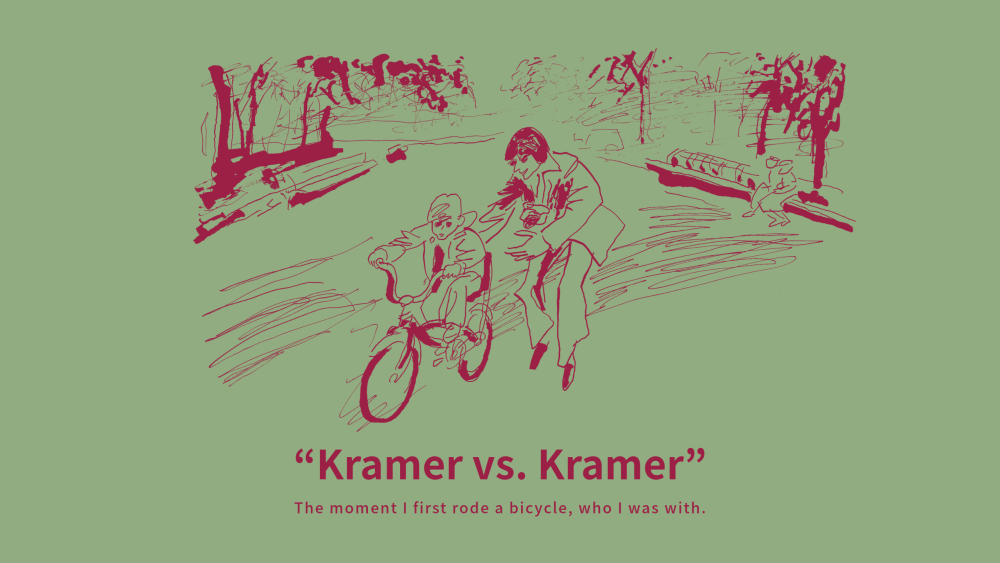
“Izakaya Choji”
The coolness of Ken-san riding a bicycle on the slopes of Hakodate.

There was a film movement called American New Cinema. It consisted of films released in the late 1960s to the 1970s such as “Easy Rider,” “The Graduate,” “Midnight Cowboy,” ” Close Encounters of the Third Kind,” and “Apocalypse Now.” Perhaps one of the reasons for the frequent use of young directors was the incorporation of messages or somewhat critical perspectives on society and politics, taking a different approach from traditional entertainment films. American New Cinema was enthusiastically supported by younger generations and had a significant influence on subsequent films.
“Kramer vs. Kramer” (1979) is also a product of the American New Cinema. The story revolves around a divorced couple and their child, with a simple narrative. The film begins with the lively music of Vivaldi’s “Mandolin Concerto RV 425”. Contrasting with this upbeat music, Joanna, played by Meryl Streep, wears a somber expression. She is on the verge of leaving, determined to leave the house without her son Billy (Meryl Streep’s performance, conveying emotions solely through expressions, is remarkable). Unaware of this, Ted (Dustin Hoffman) returns home from work, preoccupied with his job. Joanna announces her decision to leave Ted without giving a clear reason and walks out. Ted assumes she will soon return, but she doesn’t. Left to manage household chores he once left to Joanna, Ted struggles to balance parenting and work. He earnestly tries to be a good father, but Billy directs his loneliness from his mother’s departure towards Ted. Ted, exhausted both mentally and physically, faces mounting errors at work. Not only his job but also his relationship with his son deteriorates further.
One day, the two were in Central Park. Billy, astride a blue child’s bike, listened as his father advised and encouraged him on how to ride. Ted delightedly watched as Billy learned to ride the bike. Capturing the sight of his son riding a bike for the first time with a Nikon camera, Ted’s expression carried a poignant sadness, unable to share this happy moment with anyone. Sharing these moments of happiness is what defines a family. After this bittersweet yet joyous scene, Ted and Joanna begin their battle for custody of Billy.
“Kramer vs. Kramer” questioned the traditional family image of “men work, women stay home.” Even today, many can relate to it. This suggests that Japanese society may not have changed much since the younger generation questioned the old system during the American New Cinema era.

🎬CYCLE CINEMA STORAGE🎬
#01 “The Bicycle Thief”
#02 “Project A”
#03 “Shoot for tomorrow!”(origin title “Butch Cassidy and the Sundance Kid”)
#04 “The Kid With a Bike (Le gamin au vélo)”
#05 “Izakaya Choji”
#06 “Cinema Paradiso”
#07 “Kids Return”
#08 “PERFECT DAYS”
#09 “Kramer vs. Kramer”
#10 “E.T.”
#11 “Gachi-Boshi”
#12 “Yesterday”
#13 “Wadjda”
#14 “The Zone of Interest”
#15 “Anselm”
#16 “Otoko wa Turai yo”
Profile

Text_Hideki Inoue
I am from Amagasaki City, Hyogo Prefecture, Japan. I work as a writer and editor. My hobbies include hot baths, skiing, and fishing. Although I have no personal connection, I am independently conducting research on Shiga Prefecture. I prefer an active fishing style called “RUN & GUN,” which involves moving around actively instead of staying in one place. Purchasing a car to transport bicycles for this style of cycling seems like putting the cart before the horse.
Illusutration_Michiharu Saotome
Post Date:2024.03.27